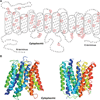SLC17: a functionally diverse family of organic anion transporters
- PMID: 23506876
- PMCID: PMC3927456
- DOI: 10.1016/j.mam.2012.05.004
SLC17: a functionally diverse family of organic anion transporters
Abstract
Molecular studies have determined that the SLC17 transporters, a family of nine proteins initially implicated in phosphate transport, mediate the transport of organic anions. While their role in phosphate transport remains uncertain, it is now clear that the transport of organic anions facilitated by this family of proteins is involved in diverse processes ranging from the vesicular storage of the neurotransmitters, to urate metabolism, to the degradation and metabolism of glycoproteins.
Copyright © 2012 Elsevier Ltd. All rights reserved.
Figures



Similar articles
-
Organic anion transport is the primary function of the SLC17/type I phosphate transporter family.Pflugers Arch. 2004 Feb;447(5):629-35. doi: 10.1007/s00424-003-1087-y. Epub 2003 Jun 17. Pflugers Arch. 2004. PMID: 12811560 Review.
-
Type 1 sodium-dependent phosphate transporter (SLC17A1 Protein) is a Cl(-)-dependent urate exporter.J Biol Chem. 2010 Aug 20;285(34):26107-13. doi: 10.1074/jbc.M110.122721. Epub 2010 Jun 21. J Biol Chem. 2010. PMID: 20566650 Free PMC article.
-
The SLCO (former SLC21) superfamily of transporters.Mol Aspects Med. 2013 Apr-Jun;34(2-3):396-412. doi: 10.1016/j.mam.2012.10.009. Mol Aspects Med. 2013. PMID: 23506880 Free PMC article. Review.
-
Successful prediction of substrate-binding pocket in SLC17 transporter sialin.J Biol Chem. 2012 Mar 30;287(14):11489-97. doi: 10.1074/jbc.M111.313056. Epub 2012 Feb 13. J Biol Chem. 2012. PMID: 22334707 Free PMC article.
-
Human sodium phosphate transporter 4 (hNPT4/SLC17A3) as a common renal secretory pathway for drugs and urate.J Biol Chem. 2010 Nov 5;285(45):35123-32. doi: 10.1074/jbc.M110.121301. Epub 2010 Sep 1. J Biol Chem. 2010. PMID: 20810651 Free PMC article.
Cited by
-
The Concise Guide to PHARMACOLOGY 2013/14: transporters.Br J Pharmacol. 2013 Dec;170(8):1706-96. doi: 10.1111/bph.12450. Br J Pharmacol. 2013. PMID: 24528242 Free PMC article.
-
Evolution of glutamatergic signaling and synapses.Neuropharmacology. 2021 Nov 1;199:108740. doi: 10.1016/j.neuropharm.2021.108740. Epub 2021 Jul 31. Neuropharmacology. 2021. PMID: 34343611 Free PMC article. Review.
-
GeneGini: Assessment via the Gini Coefficient of Reference "Housekeeping" Genes and Diverse Human Transporter Expression Profiles.Cell Syst. 2018 Feb 28;6(2):230-244.e1. doi: 10.1016/j.cels.2018.01.003. Epub 2018 Feb 7. Cell Syst. 2018. PMID: 29428416 Free PMC article.
-
Extracellular phosphate enhances the function of F508del-CFTR rescued by CFTR correctors.J Cyst Fibros. 2021 Sep;20(5):843-850. doi: 10.1016/j.jcf.2021.04.013. Epub 2021 May 18. J Cyst Fibros. 2021. PMID: 34020896 Free PMC article.
-
Local genetic covariance between serum urate and kidney function estimated with Bayesian multitrait models.G3 (Bethesda). 2022 Aug 25;12(9):jkac158. doi: 10.1093/g3journal/jkac158. G3 (Bethesda). 2022. PMID: 35876900 Free PMC article.
References
-
- Aihara Y, Mashima H, Onda H, Hisano S, Kasuya H, Hori T, Yamada S, Tomura H, Yamada Y, Inoue I, Kojima I, Takeda J. Molecular cloning of a novel brain-type Na(+)-dependent inorganic phosphate cotransporter. J Neurochem. 2000;74:2622–2625. - PubMed
-
- Alberts B, Wilson J, Hunt T. Molecular biology of the cell. 5th Edition. New York: Garland Science; 2008.
-
- Aula P, Gahl WA. In: The Metabolic and Molecular Bases of Inherited Disease. Scriver C, Beaudet AL, Sly WS, Valle D, editors. New York: McGraw-Hill; 2001. pp. 5109–5120.
Publication types
MeSH terms
Substances
Grants and funding
LinkOut - more resources
Full Text Sources
Other Literature Sources

